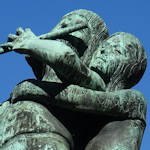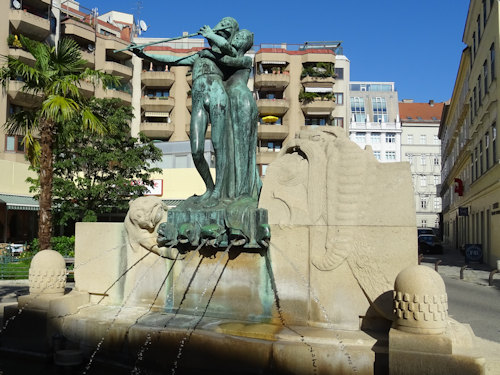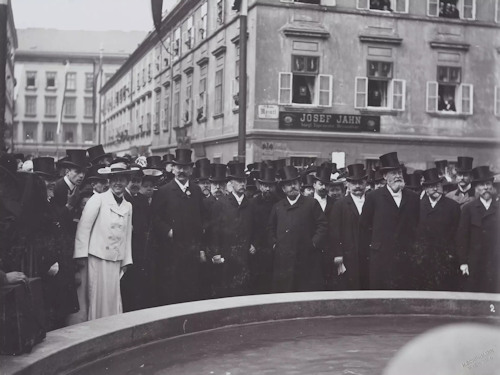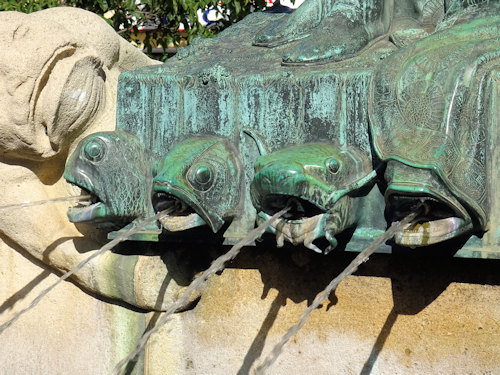
Mozart’s Tamino and Pamina achieve bronzed immortality in a fountain on Mozartplatz: an example of classic architecture from early 20th-century Vienna.
- The 1905 Jugendstil fountain
- Mirrors a scene from Mozart’s The Magic Flute
- Only worth a visit for fans of the period (or the music)
- Book a concert experience* in Vienna
- See also:
The fountain’s history

(View of Tamino and Pamina)
The Mozartbrunnen (Mozart fountain) sits at the centre of Mozartplatz (Mozart Square), itself found in the middle of Mozartgasse (Mozart Street).
So no prizes for guessing the theme at work here.
Both the square and street got their musical name in 1862, but the fountain didn’t appear until 1905.
The unveiling took place on October 8th in the presence of Vienna’s mayor, Karl Lueger. He has since fallen from grace due to his notorious antisemitism.

(Honorary guests at the fountain’s unveiling on October 8th, 1905. Interesting gender ratio. Imagine turning up without a hat; photographed by Heinrich Schuhmann (sen.); Wien Museum Inv.-Nr. 30840; excerpt reproduced with permission under the terms of the CC0 licence)
The Mozartbrunnen is also known as the Zauberflötebrunnen or “Magic Flute fountain” since it depicts a scene from the opera of the same name. Indeed, a choir sang O Schutzgeist alles Schönen from that very work at the unveiling.
Apparently, Lueger expressed the belief that the entire population of Vienna would rush to the fountain to see if it really did express the opera in physical form.
I’m guessing we can describe that sentiment as politically-expedient optimism.
The two bronze figures on the fountain are the lovers, Tamino and Pamina, who draw on the protective power of the magic flute to survive the “Trial by Water”.
You’ll find further evidence of Vienna’s love for this particular opera at, for example, the Papagenotor entrance to the Theater an der Wien.
Otto Schönthal designed the fountain, and Carl Wollek sculpted the figures. The ensemble honours the 1791 premiere of the classic opera in Vienna. Mozart conducted the orchestra himself that day, though the venue (the Theater auf der Wieden) no longer exists.
Given its date of construction, the fountain falls into one of the more creative periods of Viennese art, when Jugendstil was all the rage.

(Suitable water spouts)
Schönthal, for example, was a student and colleague of one of the fathers of modern architecture, Otto Wagner. Wollek built several other fountains during his working life, including another Mozart one in St Gilgen, near Salzburg.
Despite its artistic heritage, the fountain lies somewhat apart from the usual tourist haunts. So you may only wish to see it if you’re a fan of Mozart or turn-of-the-century design.
Having said that, the wellspring of gastronomic delights that is Bobby’s foodstore is not too far away. (This small anglo-american store has one or two things I would otherwise miss from my childhood.)
How to get to the Mozart fountain
Mozartgasse connects two of Vienna’s largest streets (Favoritenstraße and Wiedner Hauptstraße) and has subway and tram stops nearby.
Subway: The closest station is Taubstummengasse on the U1 line, which is about a 3-minute walk.
Tram: The lines 1 and 62 both stop at Paulanergasse, which is also 2-3 minutes from Mozartplatz.
Address: Mozartplatz, 1040 Vienna